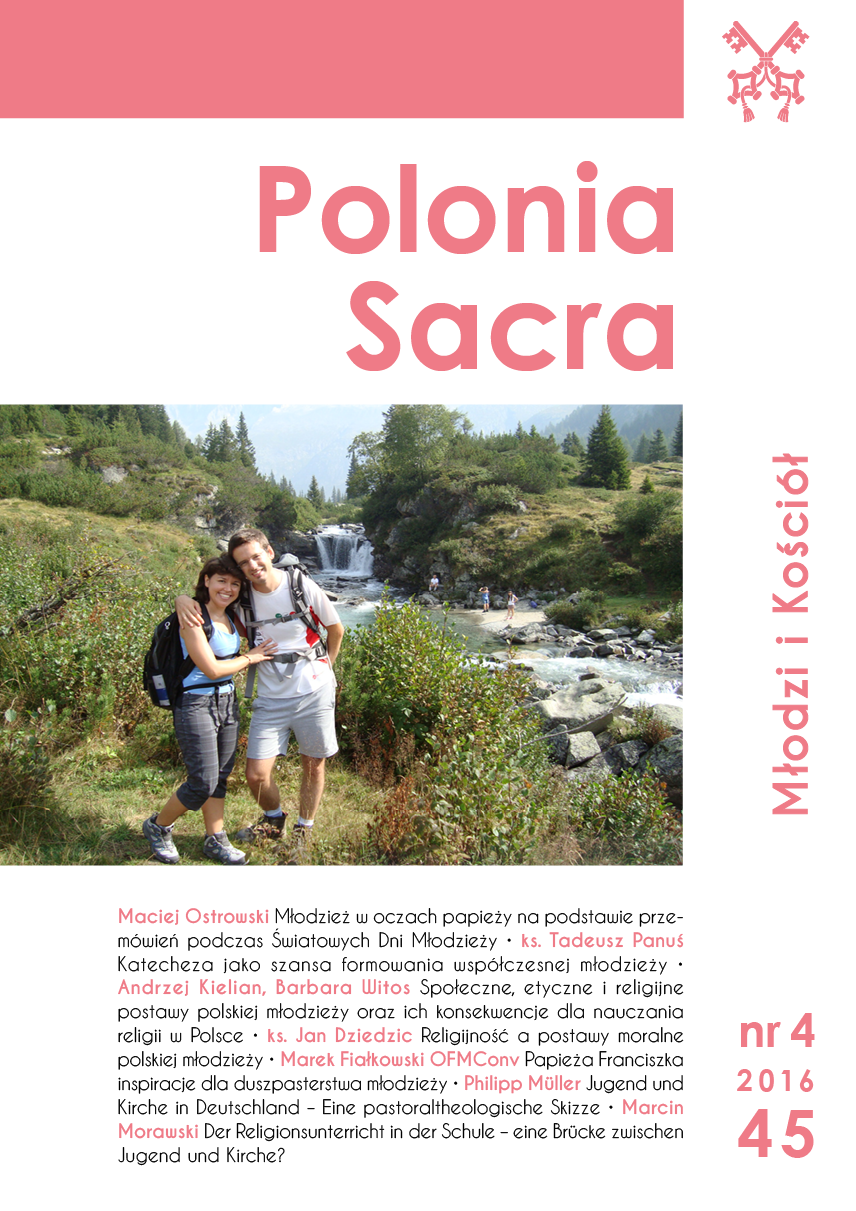Der Religionsunterricht in der Schule – eine Brücke zwischen Jugend und Kirche
DOI:
https://doi.org/10.15633/ps.1930Słowa kluczowe:
Religionsunterricht, Katechese, Religionslehrer, Religionsdidaktik, Theologie für KinderAbstrakt
Dieser Artikel befasst sich mit der Frage, inwiefern der schulische Religionsunterricht eine Brücke zwischen Jugend und Kirche sein kann, wobei die entsprechenden Dokumente des polnischen und des deutschen Episkopats, religionspädagogische Konzepte sowie Untersuchungen aus dem Bereich der Professionsforschung von Religionslehrern berücksichtigt werden. Das Hauptaugenmerk dieses Artikels liegt auf der Frage nach der Rolle der Vernunft im Prozess religiösen Lernens und, in Zusammenhang damit, zweier Ausrichtungen von Religionsunterricht im Sinne von „teaching religion“ und „teaching about religion“.Zum Schluss wird die Relevanz der Kindheit als Fundament der Brücke und die Bedeutung einer religiösen Früherziehung unterstrichen.
Bibliografia
Bucher A., Religionsunterricht zwischen Lernfach und Lebenshilfe. Eine empirische Untersuchung zum katholischen Religionsunterricht in Deutschland, Stuttgart 2000.
Die Deutschen Bischöfe, Der Religionsunterricht vor neuen Herausforderungen, Bonn 2005.
Englert R., Korrelations(didaktik). Bilanz und Perspektiven, „Religionspädagogische Beiträge” 38 (1996), S. 3–18.
Episkopat Polski, Podstawa programowa katechezy Kosciola katolickiego w Polsce, Warszawa 2010.
Feige A., „Einzelfall“ oder „Kollektiv“ – zwei Seiten einer Medaille? Übereinstimmungen in den je „quantitaiv“ und „qualitativ“ freigelegten Kernstrukturen des beruflichen Selbstverständnisses der niedersächsischen Religionslehrerschaft, [in:] Religion – Leben, Lernen, Lehren, Ansichten zur „Religion bei ReligionslehrerInnen“, Hg. B. Dressler u.a., Münster 2004, S. 9–19.
Grümme B., Alteritätstheoretische Religionsdidaktik, [in:] Religionsunterricht neu denken. Innovative Ansätze und Perspektiven der Religionsdidaktik. Ein Arbeitsbuch, Hg. B. Grümme u.a., Stuttgart 2012, S. 119–132.
Halbfas H., Symboldidaktik, [in:] Neues Handbuch religionspädagogischer Grundbegriffe, Hg. G. Bitter u.a. München 2002, S. 456–459.
Hanisch H., Das Gottesbild bei religiös und nichtreligiös erzogenen Kindern und Jugendlichen im Alter von 7–16 Jahren, www.ku-eichstaett.de/fileadmin/17/P-Meier/Glaubensdidaktik_10_-_Gottesbilder_nach_Hanisch.pdf (01.04.2016).
Heidegger M., Sein und Zeit, 18. Auflage, Tübingen 2001.
Heimeran M., Von der Religion des kleinen Kindes, Stuttgart 1957.
Lange G., Art. Bild/Bilddidaktik, [in:] Lexikon der Religionspädagogik, Hg. N. Mette, F. Rickers, Neukirchen–Vluyn 2001, S. 186–192.
Mette N., Religiöse Bildung zwischen Subjekten und Strukturen, [in:] Neues Handbuch religionspädagogischer Grundbegriffe, Hg. G. Bitter u.a., München 2002, S. 31–36.
Metz J. B., Unterbrechungen. Theologisch-politische Perspektiven und Profile, Gütersloh 1981.
Ministerium für Schule und Weiterbildung des Landes Nordrhein-Westfalen, Kernlehrplan für das Gymnasium – Sekundarstufe I in Nordrhein-Westfalen, Düsseldorf 2011.
Moser T., Gottesvergiftung, Frankfurt a. M. 1976.
Nietzsche F., Die fröhliche Wissenschaft, [in:] Nietzsche Werke. Kritische Gesamtausgabe, Hg. G. Colli, M. Montinari, fünfte Abt., 2. Bd., Berlin, New York 1973, S. 13–321.
Nietzsche F., Unzeitgemäße Betrachtungen, zweites Stück: Vom Nutzen und Nachteil der Historie für das Leben, [in:] F. Nietzsche, Werke, Nachdruck der zweibändigen Ausgabe der dreibändigen Ausgabe von K. Schlechta, Hg. I. Frenzel, Frankfurt a.M., 1999, S. 113–173.
Overbeck F., Über die Christlichkeit unserer Theologie, Darmstadt 1981, zitiert nach: A. Bucher, Kindertheologie: Provokation? Romantizismus? Neues Paradigma?, [in:] Jahrbuch für Kindertheologie Bd. 1: Mittendrin ist Gott. Kinder denken nach über Gott, Leben und Tod, Hg. A. Bucher, Stuttgart 2002, S. 9–27.
Pirner M., Professionsforschung, www.bibelwissenschaft.de/wirelex/das-wissenschaftlich-religionspädagogische-lexikon/lexikon/sachwort/anzeigen/details/professionsforschung/ch/98d4 (25.03.2016).
Polskie Dyrektorium Ketechetyczne, Warszawa 2001.
Reusser K., Pauli C., Berufsbezogene Überzeugungen von Lehrerinnen und Lehrern, [in:] Handbuch der Forschung zum Lehrerberuf, 2. überarbeitete Auflage, Hg. E. Terhart u.a., Münster 2011, S. 642–662.
Richter J. P., Levana oder Erziehlehre, zweites Bruchstück, [in:] J. Paul: Sämtliche Werke, Abt. 1., Band 5., Darmstadt 2000, S. 515–875.
Riegel U., Ziebertz H. G., Germany: teachers of religious education – meditating diverity, [in:] How Teachers in Europe Teach Religion. An International Empirical Study in 16 Countries, Hg. U. Riegel, H. G. Ziebertz, Münster 2009, S. 69–81.
Schambeck M., Mystagogisches Lernen, [in:] Ganzheitliche Methoden im Religionsunterricht, Hg. L. Rendle, 4. Aufl., München 2011, S. 351–364.
Schleiermacher F., Über die Religion. Reden an die Gebildeten unter ihren Verächtern, Stuttgart 1997.
Sławinski H., Kontekstualne uwarunkowanie głoszenia katechez do młodzieży, „Pro Musica Sacra” (13) 2015, S. 53–69.
Zajac M., Makosa P. Poland: faithfulness to God and to people. Religious education in Poland, [in:] How Teachers in Europe Teach Religion. An International Empirical Study in 16 Countries, Hg. H. G. Ziebertz, U. Riegel, Münster 2009, S. 169–181.
Pobrania
Opublikowane
Numer
Dział
Licencja
Autorzy publikujący w czasopiśmie udzielają jego wydawcy zgody o następującej treści:
- Autor zachowuje autorskie prawa majątkowe do utworu, a jednocześnie udziela wydawcy czasopisma zgody na jego pierwszą publikację w wersji drukowanej i wersji online na licencji Creative Commons Uznanie autorstwa 4.0 Międzynarodowe oraz zgody na wykonywanie opracowań, w tym przekładów.
- Autor ma możliwość udzielania zgody niewyłącznej na opublikowanie utworu w wersji, która ukazała się w czasopiśmie (np. zamieszczenia go w repozytorium instytucjonalnym lub opublikowania w książce), wraz z informacją o jego pierwszej publikacji w czasopiśmie.
- Autor może umieścić swój utwór online (np. w repozytorium instytucjonalnym lub na swojej stronie internetowej) jeszcze przed zgłoszeniem utworu do czasopisma.

